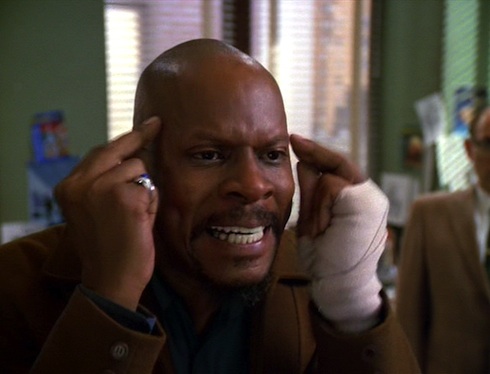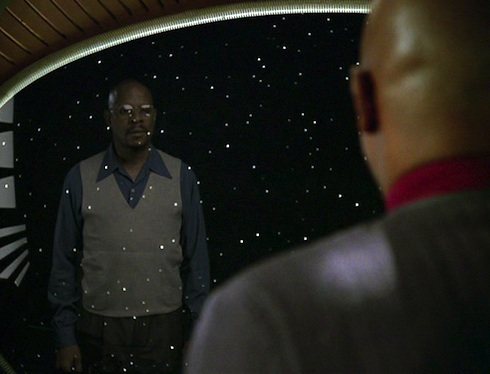Last year, I asked noted science fiction writer Paul Park if making one’s protagonist a science fiction writer could cause the character to be more sympathetic to a reader, because the occupation comes with a built-in hardship. He chuckled and said “yes, I think that’s right.” But beyond pulling emotional strings, a science fictional science fiction writer inside of a science fiction story seems like the kind of paradox one could potentially use to the destroy the universe. Is this my real life or is the “story” of my “life” ultimately the fabrication of a blogger named “Ryan” on a science fiction blog? Wait. Better stop thinking that thought or I may cease to exist.
While I struggle with the existential reality of being a science fiction version of myself, treat yourself to these six examples of invented SF writers who exist in science fiction narratives.
George McFly (Back to the Future)

We know George McFly is the density—err—destiny of Lorraine Banes, but his initial timeline did not have him becoming a celebrated science fiction author. When Marty visits his father in the first Back to the Future film, George has all the traditional traits of a total dork: bad haircut, lame clothes, no confidence, and of course, an interest in science fiction. Famously, Marty uses science fiction to convince George he is an alien with a special message. Without this one event, Marty would not have been able to put the timeline back on course; meaning science fiction inside of science fiction already saves the day in Back to the Future. But, it gets better, because in the new timeline Marty has accidentally caused his father to become a science fiction writer and, from the state of the McFly household, a reasonably successful one too!
Some naysayers may point out that A Match Made in Space is only George McFly’s first novel, which wouldn’t account from the comfortable living environment. It has been asserted that it shouldn’t have taken him this long to get the novel done and published! However, it’s possible that George McFly, after his encounter with Darth Vader from the Planet Vulcan, went on to become a hot short-story writer like Harlan Ellison or Kurt Vonnegut. Hell, George McFly may have been selling scripts to The Outer Limits or The Twilight Zone! The era for that kind of science fiction writing would certainly fit the post 1955 timeframe, and the fact that the McFlys live in California, near the TV world action, makes it all the more plausible. You could even say that in Marty’s reality, George McFly sued both Gene Roddenberry and George Lucas over the use of his original concepts “Darth Vader” and “The Planet Vulcan.” Which means, Marty McFly, through his father, inadvernately created both Star Trek and Star Wars. If such a thing were true, it would make Back to the Future retroactively a work of non-fiction.
Kilgore Trout (SlaughterHouse-Five, Breakfast of Champions, Timequake, et al. by Kurt Vonnegut)
Though initially based on famous SF writer Theodore Sturgeon (both fish-get it?), Kilgore Trout later came to represent an alter ego of Vonnegut himself. Trout is in many ways the embodiment not only of how science fiction authors are perceived, but also how they perceive themselves. Trout is a martyr insofar as he is highly prolific, but almost never read. Most of his short stories and novels are published inside of pornographic digests, or worse, not published at all. In Breakfast of Champions Vonnegut tells the reader that Kilgore Trout knows nothing about actual science, despite being known as a science fiction writer. Throughout his various appearances, Trout’s fiction influences the plots of Vonnegut’s books both metaphorically and actually. In fact, it is the reading of a Kilgore Trout novel which causes the character Dwayne Hoover to go on a violent rampage. In Slaughter House-Five, much of Trout’s work neatly dovetails the themes that Billy Pilgrim is experiencing. In Timequake, Trout himself is center stage, caught up in an event which seems to echo one of his own short stories.
Kilgore Trout seems to be closely associated with madness as both the characters of Dwayne Hoover and Eliot Rosewater (of God Bless You, Mr. Rosewater) have episodes akin to a nervous breakdown and are both readers of Kilgore Trout. The character is at once sympathetic and irritating to a reader as he is at vulgar and wise. Much of Vonnegut’s cynicism about society at large comes through the brief Kilgore Trout vignettes. Trout’s novel read by Dwayne in Breakfast of Champions depicts a world entirely made of robots in which only the reader of the novel is truly human. In this way, Kilgore Trout’s “fiction” represents those instances when science fiction is truly banal and brilliant at the same time.
Benny Russell (Star Trek: Deep Space Nine “Far Beyond the Stars”)

In this correctly praised Deep Space Nine episode, Captain Sisko imagines himself to be a black science fiction writer living in the 1950s, literally writing the story of space station Deep Space 9. Benny is one of several staff writers for Incredible Tales, a fictional science fiction magazine existing in the same Golden Age of science fiction as magazines like Galaxy. In this 1950s context, Benny’s “Deep Space Nine” story is controversial, because it depicts a black man as the commander of a space station in the future. This was a nice reference to some of the racial barriers that original Trek tackled as well as making Sisko—as the episode says—both “the dreamer and the dream” simultaneously. The episode also superficially references the classic show by having several in-universe published SF stories share their titles with classic Trek episodes. Further, both Galaxy and Incredible Tales feature re- appropriations of matte paintings done for the 60’s show.
Benny Russell pops up again in the DS9 episode “Shadows and Symbols” in which he’s a representation of Sisko’s sanity and an embodiment of his tendency to press on despite obstacles. The writers of Deep Space Nine liked the Benny Russell meta-fiction so much, that they considered having the final shot of the DS9’s finale “What You Leave Behind” depict Benny walking to the Paramount Pictures lot where the show was being filmed.
Paul Park (Paul Park stories)
In many of SF author (and poet!) Paul Park’s stories, the author appears as a sort of metafictional version of himself, in the guise of a science fiction author. In “Ghosts Doing the Orange Dance” the protagonist even has a father who tries his hand at science fiction after the main character becomes an SF writer. In “The Persistence of Memory or This Space For Sale” an author writes a story for another character based on their winning a contest in which they can have a story written about them. In the story called “Untitled 4” a science fiction author’s work is so potent that the character is imprisoned for writing a book called Thirteen Steps, which even the reading of causes major political turmoil. As far as contemporary, dark literary meta-fiction goes, Paul Park is the master. (More on Paul Park and meta-fiction here.)
Cordwainer Bird (Harlan Ellison stories)
Despite his brilliance, Harlan Ellison’s reputation for controversy sometimes overshadows his overall oeuvre. However, agree with him or not, the majority of Ellison’s dust-ups have dealt with the protection of the writer as an entity. Further, Ellison disliked genre biases so much, that for a time he refused to be referred to as a science fiction writer. During his many gigs writing for television, Ellison would often disagree with changes made to his scripts, and if something went too far in his opinion, he’d ask for his name to be removed and replaced with Cordwainer Bird. This is a pyseudom Ellison used when he wrote erotica, but also a reference to Cordwainer Smith, the pen name of SF writer Paul M.A. Linebarger. Unlike the fondness Vonnegut seemed to have for Trout, Cordwainer Bird seem to be more of a middle-finger to the establishment whether they be the literary elite, or Hollywood phonies.
However, Bird does make a fictional appearance in the Ellison story called “The New York Review of Bird” in which the fictional author finds many of his books shoved into a terrible cellar of a bookstore and resolves to go on a rampage of epic proportions. Hunter S. Thompson may have been more specific in his literary rage, but no one was truly angrier than Cordwainer Bird.
AF Gordon Theodore & Joel Munt (Party Down)
In the episode entitled “Joel Munt’s Big Deal Party” Roman discovers his old writing partner Joel Munt is adapting a movie version of a famous science fiction novel by a writer named AF Gordon Theodore. Though AF Gordon Theodore is a more obvious homage to someone like Theodore Sturgeon, we get two fake SF writers at the same time with the addition of the hacky Joel Munt. The conversations revolving around the screen adaptations are hilarious, as are Roman’s dismissal of fantasy against science fiction. Though hyperbolic and not necessarily realistic science fiction, this commentary is laugh-out-loud funny for anyone who knows anything about speculative writing and the culture that surrounds it.
Honorable mentions: Montese Crandall from The Four Fingers of Death by Rick Moody, Wilson Taylor from the graphic novel series Unwritten by Mike Carey, and Ronald Chevalier from the film Gentlemen Broncos.
Any other fictional science fiction authors? Let us know below!
Ryan Britt is the staff writer for Tor.com. He appears in his own stories and blogs all the time. He’s even in this byline.










